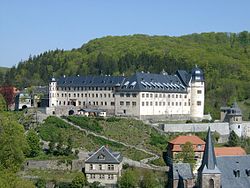County of Stolberg-Stolberg Grafschaft Stolberg-Stolberg | |||||||||||||||
|---|---|---|---|---|---|---|---|---|---|---|---|---|---|---|---|
| 1548–1803 | |||||||||||||||
| Status | State of the Holy Roman Empire | ||||||||||||||
| Capital | Stolberg | ||||||||||||||
| Government | Principality | ||||||||||||||
| Historical era | Middle Ages | ||||||||||||||
• Division of Stolberg | 19 March 1548 | ||||||||||||||
| 31 May 1645 | |||||||||||||||
| 1706 | |||||||||||||||
| 1730–38 | |||||||||||||||
• Mediatised to Saxony | 1803 | ||||||||||||||
| 1815 | |||||||||||||||
| |||||||||||||||


Stolberg-Stolberg was a county of the Holy Roman Empire located in the southern Harz region. Its capital was the town of Stolberg, now in Saxony-Anhalt, Germany. It was ruled by a branch of the House of Stolberg.
Contents
In 1429, the County of Wernigerode passed to the Counts of Stolberg, who ruled Wernigerode through a personal union. In 1548, the line was split between a Harz line (Stolberg-Stolberg) and a Rhenish line which had possessions in Rochefort (Stolberg-Rochefort) and Königstein im Taunus (Stolberg-Königstein).
With the death of Count Wolf Georg zu Stolberg in 1631, Stolberg-Stolberg was inherited by members of the Rhenish line. On 31 May 1645, Stolberg-Stolberg was divided between a senior Stolberg-Wernigerode line and a junior Stolberg-Stolberg line. In 1706, Stolberg-Stolberg divided again, with Stolberg-Rossla being created.
Stolberg-Stolberg was forced to recognize the suzerainty of the Electorate of Saxony in 1738. It was awarded to the Kingdom of Prussia in the 1815 Congress of Vienna.
The children of Fürsten and Erbprinzen zu Stolberg-Wernigerode bore the title of Prince[ss] (Prinz[essin]) zu Stolberg-Wernigerode and were styled Serene Highness. Other members of this line bore the title of Count[ess] ( Graf/Gräfin) zu Stolberg-Wernigerode, with the style of Illustrious Highness.

